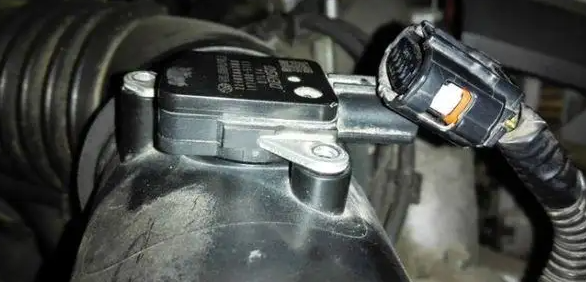What is a Mass Air Flow sensor?
A Mass Air Flow (MAF) sensor is a device used in the automotive industry to measure the amount of air entering the engine. It is a critical component of the engine management system.
The primary function of a MAF sensor is to accurately measure the mass of air flowing into the engine. This information is vital for the engine control unit (ECU) to calculate and deliver the appropriate amount of fuel for efficient combustion. The MAF sensor helps ensure the correct air-fuel ratio, which is essential for optimal engine performance, fuel efficiency, and emissions control.
The MAF sensor achieves this measurement by utilizing a heated wire or a hot film element. As the air flows over the heated element, it cools it down. The sensor measures the cooling effect and converts it into an electrical signal. The magnitude of this signal corresponds to the mass of the airflow.
The MAF sensor then sends this information to the ECU, which uses it in conjunction with other sensor data to make real-time adjustments to fuel injection, ignition timing, and other engine parameters. By continuously monitoring and adjusting the air-fuel mixture, the MAF sensor helps ensure that the engine runs smoothly, efficiently, and within the desired operating range.
Should the MAF sensor become dirty, contaminated, or malfunction, it can provide inaccurate readings to the ECU. This can lead to various issues, including reduced engine performance, poor fuel efficiency, rough idling, or even engine stalling. In such cases, the MAF sensor may need to be cleaned or replaced to restore proper engine operation.
Releated: How to Clean MAF Sensor with Cleaner or Alcohol
How MAF sensors work?
The MAF sensor is typically located in the intake air duct, between the air filter and the engine's throttle body. It works by utilizing a heated wire or a heated film element that is exposed to the incoming air. As air flows over the element, it cools it down, and the sensor measures the change in temperature. This temperature change is then converted into an electrical signal that is sent to the ECU.
The ECU uses the information from the MAF sensor, along with data from other sensors, to calculate the optimum fuel-to-air ratio for combustion. This ensures that the engine runs efficiently and produces the right amount of power while minimizing fuel consumption and emissions.
The MAF sensor also helps the ECU adjust the fuel injection timing and ignition timing based on the air flow rate. It is an essential component for the engine's performance, fuel economy, and emission control.
Also read: How to Test Ignition Coil with Multimeter
The types of MAF sensors
There are primarily two types of Mass Air Flow (MAF) sensors commonly used in vehicles:

- Hot Wire MAF Sensor: This type of MAF sensor uses a heated wire element to measure the incoming air flow. The wire is electrically heated to a specific temperature, and as air flows over it, the cooling effect changes the wire's electrical resistance. The change in resistance is then converted into an electrical signal that is sent to the engine control unit (ECU) to calculate the air flow rate.
- Hot Film MAF Sensor: This type of MAF sensor uses a thin film element that is heated to a constant temperature. Similar to the hot wire sensor, as air flows over the film, it cools it down, causing a change in resistance. This resistance change is then converted into an electrical signal that is used by the ECU to determine the air flow rate.
Both types of MAF sensors work on the principle of measuring the cooling effect of the incoming air, but they differ in the specific design and technology used.
It's important to note that some vehicles may use alternative air flow measurement methods, such as manifold absolute pressure (MAP) sensors or combination sensors that integrate MAF and MAP functions. The specific type of MAF sensor used can vary depending on the vehicle make and model.
Symptoms of a bad mass air flow sensor
A faulty Mass Air Flow (MAF) sensor can cause various symptoms in a vehicle. Here are some common symptoms that may indicate a bad MAF sensor:
- Check Engine Light: A malfunctioning MAF sensor can trigger the check engine light to illuminate on the dashboard. The vehicle's onboard diagnostic system may detect irregularities in the MAF sensor's readings and store fault codes related to the issue.
- Engine Performance Issues: A bad MAF sensor can lead to a decline in engine performance. You may experience reduced power, hesitation, or sluggish acceleration. The engine might also run rough or misfire.
- Poor Fuel Efficiency: An inaccurate MAF sensor reading can disrupt the proper air-fuel mixture, resulting in decreased fuel efficiency. You may find yourself needing to refuel more frequently for the same distance traveled.
- Rough Idle: A faulty MAF sensor can cause an unstable or rough idle. The engine may fluctuate in RPMs or exhibit inconsistent idling behavior.
- Stalling or Difficulty Starting: In severe cases, a malfunctioning MAF sensor can cause the engine to stall or have difficulty starting. This occurs when the sensor fails to provide accurate air intake information, leading to improper fuel delivery.
- Reduced Performance at High RPMs: A failing MAF sensor may struggle to accurately measure air intake at higher engine speeds, causing a loss of power or hesitation at high RPMs.
- Lean or Rich Fuel Mixture: If the MAF sensor is providing incorrect readings, it can result in a lean or rich air-fuel mixture. A lean mixture can cause engine overheating or damage, while a rich mixture can lead to increased emissions and poor performance.
If you experience any of these symptoms, it is recommended to have your vehicle inspected by a qualified mechanic who can diagnose the issue and determine if the MAF sensor needs cleaning, calibration, or replacement.
Also read: Why is my engine light blinking and how to fix it?
Common faulty codes
P0100 - Mass or Volume Air Flow Circuit Malfunction: This code indicates a general problem with the MAF sensor circuit. It could be caused by a faulty sensor, wiring issues, or a problem with the engine control module (ECM).
P0101 - Mass or Volume Air Flow Circuit Range/Performance Problem: This code suggests that the MAF sensor is providing readings outside the expected range or performance parameters. It may indicate a problem with the sensor itself, a vacuum leak, or an issue with the air intake system.
P0102 - Mass or Volume Air Flow Circuit Low Input: This code indicates that the MAF sensor is providing a lower than expected voltage signal. It could be due to a problem with the sensor, a dirty sensor element, or a wiring issue.
P0103 - Mass or Volume Air Flow Circuit High Input: This code indicates that the MAF sensor is providing a higher than expected voltage signal. It could be caused by a problem with the sensor, a contaminated sensor element, or a wiring issue.
P0171 - System Too Lean (Bank 1): This code indicates that the engine is running with a lean air-fuel mixture on one bank of cylinders. It can be triggered by a faulty MAF sensor providing inaccurate readings, a vacuum leak, or other fuel delivery issues.
P0172 - System Too Rich (Bank 1): This code indicates that the engine is running with a rich air-fuel mixture on one bank of cylinders. It can be caused by a faulty MAF sensor providing incorrect readings, a fuel pressure regulator problem, or injector issues.
Also read: P0325/P0332 Knock Sensor Code: Causes, Symptoms and Fixes
How to test a MAF sensor
Locate the MAF Sensor: The MAF sensor is typically located in the intake air duct near the air filter housing. Consult your vehicle's service manual or online resources to find the exact location.
Inspect the Sensor: Check for any physical damage, loose connections, or debris on or around the sensor. If you notice any issues, address them before proceeding with the testing.
Check for Power and Ground: Use a multimeter to test if the MAF sensor is receiving power and has a good ground connection. Consult your vehicle's service manual for the specific voltage and ground specifications. If there is no power or ground, check the wiring and connections for any faults.
Measure Voltage Signal: With the engine off, disconnect the electrical connector from the MAF sensor. Set your multimeter to the voltage setting and connect the positive lead to the signal wire terminal (consult your vehicle's service manual for the specific terminal). Connect the negative lead to a good ground. Turn on the ignition, but do not start the engine.
Measure Voltage at Idle: Start the engine and let it idle. Observe the voltage reading on the multimeter. The exact voltage range will vary depending on the vehicle, but it should be within the specified range in your service manual. If the voltage is outside the expected range, it could indicate a problem with the MAF sensor.
Measure Voltage at Various RPMs: While keeping the engine running, gradually increase the RPMs and observe the voltage reading on the multimeter. The voltage should increase proportionally with the increase in RPM. If the voltage does not change or fluctuates erratically, it may indicate a faulty MAF sensor.
Inspect the Sensor for Contamination: If the voltage readings are abnormal or inconsistent, visually inspect the MAF sensor for any contamination or debris. A dirty or contaminated sensor can cause inaccurate readings. Clean the sensor using MAF sensor cleaner, following the instructions provided by the manufacturer.
If your testing indicates a faulty MAF sensor, it is recommended to consult a qualified mechanic for further diagnosis and potential replacement. They may use more advanced diagnostic tools to confirm the issue and ensure accurate results.
How to replace a faulty MAF sensor?(steps & price)
The steps to replace a faulty Mass Air Flow (MAF) sensor:
- Gather the necessary tools: Before starting the replacement process, make sure you have the appropriate tools for the job. This may include a socket wrench or screwdriver, depending on the specific requirements of your vehicle.
- Locate the MAF sensor: Refer to your vehicle's service manual or online resources to identify the exact location of the MAF sensor. It is typically located in the intake air duct, near the air filter housing.
- Disconnect the electrical connector: Carefully disconnect the electrical connector from the MAF sensor. Depending on the connector type, you may need to press a release tab or use a small tool to unlock it.
- Remove the MAF sensor: Use the appropriate tool to remove any fasteners securing the MAF sensor in place. It may be held in position by screws, clamps, or mounting brackets. Gently pull the sensor out of the intake air duct.
- Install the new MAF sensor: Take the new MAF sensor and align it with the mounting position in the intake air duct. Make sure it is correctly positioned. Secure the sensor in place using the appropriate fasteners.
- Reconnect the electrical connector: Plug the electrical connector into the new MAF sensor. Ensure it is securely connected and locked in place.
- Test the replacement: Start the engine and observe its performance. Check if the check engine light is illuminated and monitor for any abnormal symptoms. If everything appears to be functioning properly, the replacement is successful.
The replacement prices:
Regarding the price of a MAF sensor, it can vary depending on the vehicle make and model, as well as the brand and quality of the sensor. On average, a MAF sensor can range from $50 to $200 or more. However, it's always best to check with local auto parts stores or online retailers for the most accurate and up-to-date pricing information.
MAP sensor vs MAF sensor
MAP sensors and MAF sensors both play an important role in engine management systems. They all play an important role when it comes to engine tuning or performance optimization. But they serve different purposes, measuring different aspects of the airflow inside the engine.
MAP Sensor:
The MAP sensor measures the absolute pressure inside the intake manifold of the engine. It provides the engine control unit (ECU) with information about the engine load, which helps determine the appropriate fuel injection timing and quantity. The MAP sensor is typically a small, electronic sensor mounted on or near the intake manifold.
MAF Sensor:
The MAF sensor, on the other hand, measures the mass of air entering the engine. It calculates the amount of air flowing through the intake system and provides this data to the ECU. The ECU uses this information to determine the correct fuel delivery for optimal combustion. The MAF sensor is usually located in the intake air duct, near the air filter housing.
Differences between MAP Sensor and MAF Sensor:
- Measurement Principle: The MAP sensor measures the absolute pressure in the intake manifold, while the MAF sensor measures the mass of air flowing into the engine.
- Air Temperature Compensation: The MAP sensor does not directly measure air temperature, while some MAF sensors include temperature sensors to compensate for temperature variations in the airflow.
- Engine Load Calculation: The MAP sensor helps determine the engine load based on the absolute pressure in the intake manifold, while the MAF sensor provides the ECU with the actual mass of air entering the engine, which indirectly contributes to load calculations.
- Applications: The MAP sensor is commonly used in naturally aspirated and forced induction engines, while the MAF sensor is primarily utilized in naturally aspirated engines. However, some engines may use both sensors or a combination of the two.
It's important to note that the specific configuration and usage of MAP and MAF sensors can vary across different vehicle models and manufacturers. The choice of which sensor(s) to use in an engine management system depends on factors such as engine design, performance requirements, and emission regulations.






